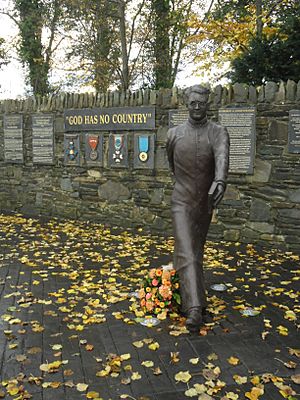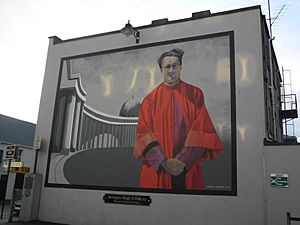Hugh O'Flaherty facts for kids
Quick facts for kids The Right Reverend Monsignor Hugh O'Flaherty CBE |
|
|---|---|
 |
|
| Church | Catholic Church |
| Orders | |
| Ordination | 20 December 1925 |
| Personal details | |
| Born | 28 February 1898 Lisrobin, Kiskeam, County Cork, Ireland |
| Died | 30 October 1963 (aged 65) Cahersiveen, County Kerry, Ireland |
| Buried | Daniel O'Connell Memorial Church |
| Alma mater | Mungret College |
Hugh O'Flaherty (28 February 1898 – 30 October 1963) was an Irish Catholic priest. He became famous during World War II for saving thousands of people. He helped over 6,500 Allied soldiers and Jews escape danger.
He was so good at avoiding the German secret police, the Gestapo, that he was called "The Scarlet Pimpernel of the Vatican". After the war, he received special honors from the Pope. He continued to work for the Vatican until 1960.
Contents
The Early Life of Hugh O'Flaherty
Hugh O'Flaherty was born in Lisrobin, County Cork, Ireland. Soon after his birth, his family moved to Killarney. His father worked at the local golf course. Young Hugh became a very skilled golfer himself.
In 1918, when he was about 20, he decided to study for the priesthood. He joined Mungret College in County Limerick. This college helped young men prepare to become missionaries. After his studies, he went to Rome in 1922.
He became a priest on 20 December 1925. Instead of going to a faraway mission, he stayed in Rome. He worked as a diplomat for the Holy See in different countries. These included Egypt, Haiti, and Czechoslovakia. By 1934, he was given the special title of Monsignor.
Saving Lives During World War II
When World War II began, Monsignor O'Flaherty visited prisoner-of-war (POW) camps in Italy. He tried to find missing soldiers and let their families know they were safe. He would share news through Radio Vatican.
In 1943, Italy changed sides in the war. Thousands of Allied POWs were set free. But then Germany took control of Italy. The freed prisoners were in danger of being captured again. Many of them remembered O'Flaherty's visits. They came to Rome asking for his help.
Building a Secret Network
Monsignor O'Flaherty did not wait for permission. He quickly started a secret network to help people. He got help from other priests, including two young New Zealanders. He also worked with French agents, communists, and even a Swiss count.
One important helper was British Major Sam Derry, an escaped prisoner. They worked together to keep the network safe and organized. O'Flaherty also stayed in touch with the British Ambassador to the Holy See, Sir D'Arcy Osborne.
O'Flaherty and his helpers hid about 4,000 people. Most were Allied soldiers and Jews. They hid them in apartments, farms, and convents. They even hid some very close to the German SS headquarters!
Evading the Gestapo
Monsignor O'Flaherty often wore disguises when he left the Vatican. The German secret police, the Gestapo, tried to catch him. They soon learned that a priest was leading the rescue efforts. But they could not arrest him inside the Vatican City.
The head of the SS in Rome, Herbert Kappler, knew about O'Flaherty. He had a white line painted on the ground at the edge of St. Peter's Square. This line marked the border between Vatican City and Italy. Kappler said O'Flaherty would be killed if he crossed it. So, O'Flaherty started meeting his contacts on the stairs of St. Peter's Basilica, which was inside the Vatican.
Many other brave people helped O'Flaherty. They included priests, nuns, and ordinary people. They hid refugees in their own homes. When the Allies finally arrived in Rome in June 1944, over 6,400 of the people O'Flaherty helped were still safe. He even made sure German prisoners were treated well.
After the War
After the war, Monsignor O'Flaherty received many awards. He was given the Commander of the Order of the British Empire (CBE) from Britain. He also received the American Medal of Freedom. Canada and Australia honored him too. He refused a lifetime pension from Italy.
In 1954, he received another special title from the Pope. He was the first Irishman to hold a high position in the Vatican called Notary of the Holy Office.
A Surprising Friendship
One of the most surprising things O'Flaherty did was visit his old enemy, Herbert Kappler. Kappler was the former SS chief in Rome who had tried to catch and kill O'Flaherty. Kappler was in prison, and O'Flaherty was his only visitor for many years.
In 1959, Kappler decided to become a Catholic. Monsignor O'Flaherty was the one who baptized him. This showed O'Flaherty's great kindness and forgiveness.
His Legacy and Memorials
In 1960, Monsignor O'Flaherty had a serious stroke. He had to return to Ireland. He moved to Cahersiveen to live with his sister. He passed away there on 30 October 1963, at the age of 65.
He was buried in the cemetery of the Daniel O'Connell Memorial Church in Cahersiveen. There is a monument in Killarney Town in his memory. A group of trees is also dedicated to him in the Killarney National Park.

Some people believe he was honored as "Righteous Among the Nations" by Israel. This award is for non-Jews who saved Jews during the Holocaust. While he is not officially on the list yet, efforts are being made to add him.
Stories About Him
Monsignor O'Flaherty's incredible story has been told in different ways.
- He was played by actor Gregory Peck in the 1983 TV movie, The Scarlet and the Black. This film shows his adventures during the German occupation of Rome.
- A radio play called The Scarlet Pimpernel of the Vatican was made about him.
- An Irish actor, Donal Courtney, wrote and performed a one-man play about O'Flaherty called "God has no Country."
- In 2023, a novel based on his story, "My Father's House," was published by Joseph O’Connor.
The Irish-language TV station TG4 also made a documentary about him in 2008. It is called The Pimpernel of the Vatican – The Amazing Story of Monsignor Hugh O'Flaherty.


